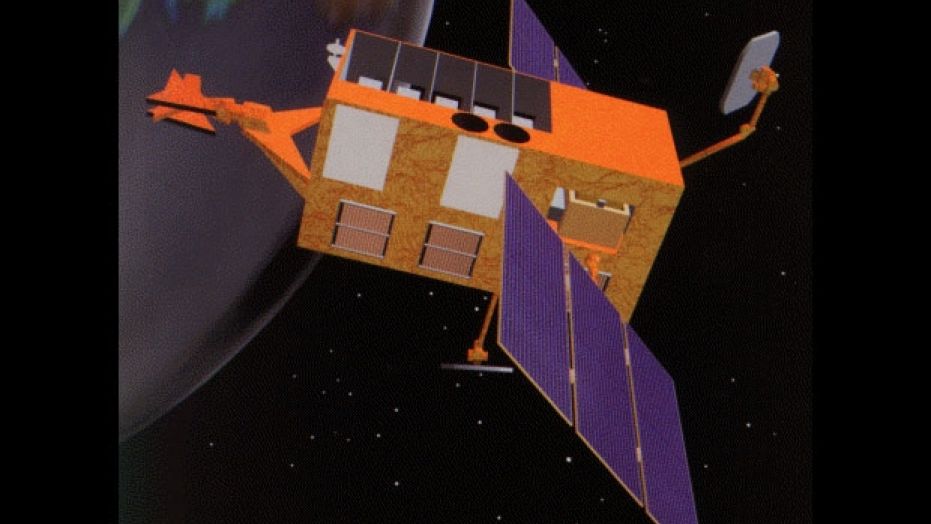On April 30, after more than 20 years in
space,
NASA's Rossi X-ray Timing Explorer (
RXTE)
satellite re-entered and burned up in
Earth's atmosphere. Decommissioned in 2012, the instrument spent its lifetime probing the environments of black holes and neutron stars in X-ray wavelengths, revealing new insight into these dense gravitational objects.

"Observing these X-ray phenomena with precise high-resolution timing was RXTE's specialty," Jean Swank, an astrophysicist emeritus at NASA's Goddard Space Flight Center in Greenbelt, Maryland, who served as the mission's project scientist until 2010, said in a statement. "During RXTE's run, no other observatory could provide these measurements."
Launched in December 1995 from Cape Canaveral Air Force Station in Florida, the mission was originally referred to as XTE. It was renamed in 1996 to honor Bruno Rossi, an MIT astronomer and pioneer of X-ray astronomy and space plasma physics who died in 1993. [Images: Black Holes of the Universe]
RXTE relayed its last scientific observation to the ground on Jan. 4, 2012, and was powered down the next day. By then, the spacecraft had made several important scientific observations.
"RXTE far exceeded its original goals and leaves behind an important scientific legacy," NASA officials said in the same statement.
A wealth of scienceAfter a star explodes in a fiery supernova death, it can leave behind a core of packed-together neutrons called a neutron star. These incredibly dense objects can squeeze the mass of the sun into a city-size object. Exploding stars can also leave behind even smaller and denser black holes.
The strong gravity of black holes and neutron stars can pull material from nearby companion stars into their own orbit, forming what's called an accretion disk. Friction heats the orbiting gas to temperatures of millions of degrees — hot enough to emit X-rays. As the gas spirals inward, powerful X-ray bursts, flares and pulsations can explode in the innermost reaches of the accretion disk and on the surface of neutron stars.
Signals from these features can be incredibly brief — only a few seconds at most and sometimes less than a millisecond. Those short-lived X-ray bursts can provide important information on the compact object at the heart of the disk.
In 1997, RXTE provided the first observational evidence for "frame dragging," an effect based on Einstein's theory of general relativity and predicted 79 years earlier by Austrian physicists Joseph Lense and Hans Thirring. Massive objects like black holes warp the space-time around them, much like a bowling ball deforms a stretched elastic sheet — a phenomenon already revealed by other experiments. If the object rotates, the black hole catches hold of nearby space-time and drags it along, including the inner accretion disk, much as the rotating bowling ball would twist and distort the sheet. RXTE was able to track fast X-ray oscillations of hot gas deep within the accretion disk to catch the relativistic behavior.
RXTE also revealed that black holes of extremely different masses produce similar kinds of X-ray activity. Their activity varies at time scales proportional to their masses. Stellar-mass black holes undergo changes in a matter of hours, while supermassive black holes, which bear the mass of millions of stars, make similar changes over a period of years.
The mission also provided proof of the existence of a new type of neutron star known as a magnetar. While normal neutron stars produce magnetic fields up to 10 trillion times stronger than Earth's, magnetars boast fields a thousand times stronger than that, meaning they possess the most powerful magnetic fields known in the universe. Of the approximately 2,600 neutron stars currently cataloged, only 29 are classified as magnetars.
All of the data collected by RXTE is open to the public at NASA Goddard's High Energy Astrophysics Science Archive Research Center.
"The data remain a treasure trove for studying compact objects, whether pulsars and stellar-mass black holes in our own galaxy or supermassive black holes in the cores of distant galaxies," Goddard's Tod Strohmayer, who served as RXTE's project scientist from 2010 through the end of the mission, said in the statement. "So far, more than 3,100 published papers in refereed journals, totaling over 95,000 citations, include RXTE measurements."
The astronomical community has recognized the importance of RXTE's contributions, honoring the research with five major awards. These include four Bruno Rossi Prizes (1999, 2003, 2006 and 2009) from the High Energy Astrophysics Division of the American Astronomical Society and the 2004 Spinoza Prize, the highest Dutch science award, from the Netherlands Organization for Scientific Research.
Although the mission came to an end in 2012, RXTE's niche has not been neglected. In 2017, NASA's Neutron star Interior Composition Explorer (NICER) began to study variable X-ray sources from its perch on the skyward side of the International Space Station.
"NICER is the successor to RXTE, with an order-of-magnitude improvement in sensitivity, energy resolution and time resolution," Goddard's Keith Gendreau, principal investigator for the NICER mission, said in the statement. "The X-ray band NICER observes overlaps the lower end of RXTE's range, which means we can more easily take advantage of its long observational record."
When NASA originally retired RXTE in 2012, it was predicted to fall to Earth between 2014 and 2023. Fluctuations in solar activity that affect Earth's atmosphere made it difficult to precisely predict the satellite's fall at the time. Its launch before NASA issued standards for public safety from re-entering spacecraft meant that it had a 1-in-1,000 chance of harming someone when it crashed back to Earth — 10 times riskier than NASA's current requirements for re-entering spacecraft. RXTE beat those odds, entering Earth's atmosphere over the tropics without harming anyone.
Since the beginning of the Space Age, there have been no confirmed injuriescaused by falling satellites.